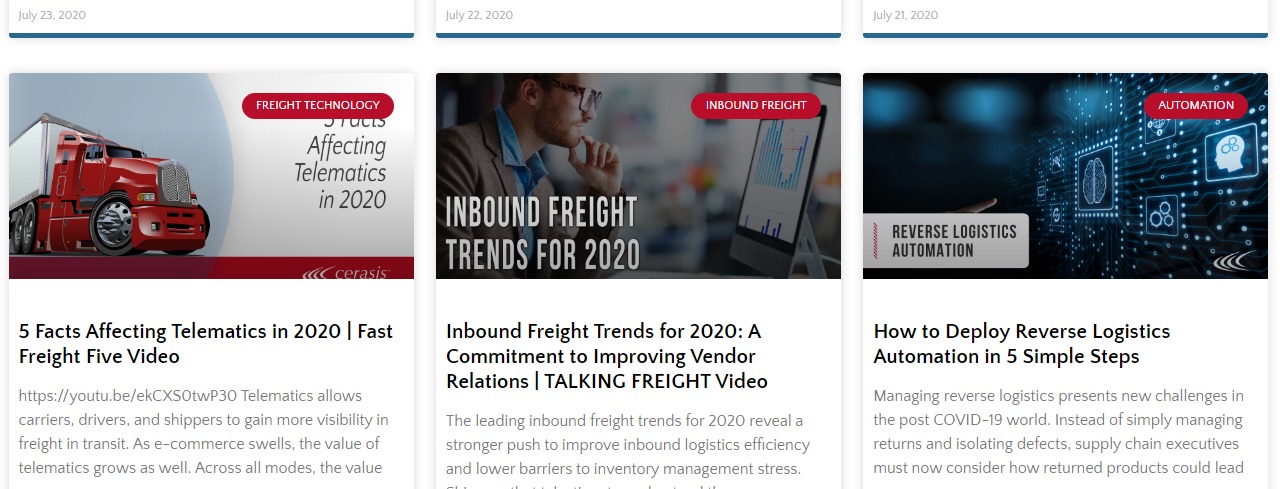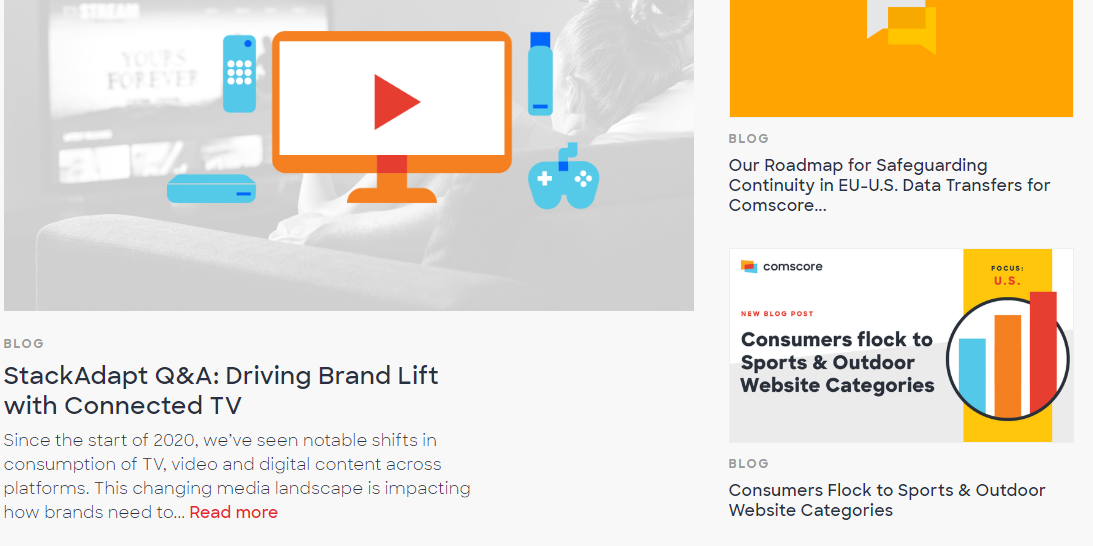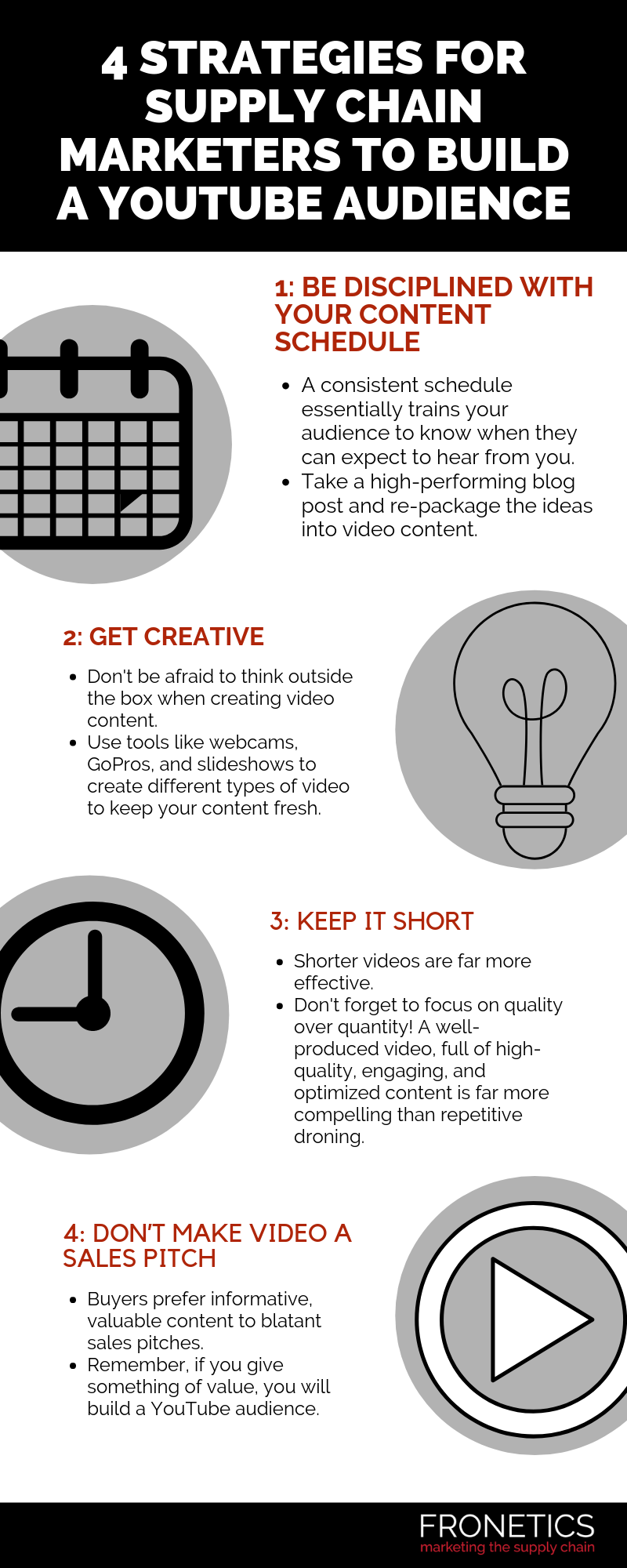
by Fronetics | Jul 23, 2020 | Blog, Content Marketing, Covid-19, Marketing, Strategy
The benefits of a B2B blog are too important to overlook. Plus: Three companies that excel at content creation.
If your company blog has gone the way of the bears in winter, there is good reason to bring it back to life. That stale page on your website is more important than may realize. When months and even years go by without a single update, you’re missing out on company blog benefits.
Let’s cut straight to the stats:
- 70% of respondents in a Databox survey said SEO is better than pay-per-click (PPC) advertising for generating sales. (Can you guess what a leading driver of website SEO is?)
- Blogs are among the top 3 tools used in content strategies (HubSpot 2020).
- 51% of companies say updating old content has proven to be the most efficient tactic implemented (SEMrush, 2019). (See our post on reworking content for SEO here.)
- 67% of companies use organic traffic to measure content success (SEMrush, 2019). (You guessed it: A blog is a key tool in boosting organic search traffic.)
- 72% of online marketers say content creation is their most effective SEO tactic.
- Companies with blogs generate 97% more inbound links and 434% more indexed pages than those without.
In other words, a company blog brings benefits beyond just being a source of information, a tool to communicate with prospects, and to build brand. Despite new technologies, text will — as HubSpot points out in its 2020 State of Marketing Report — always be the foundation of search. And no place allows you to add descriptive text for improved search rankings as much as a company blog.
Not seeing company blog benefits? Here are 4 common pitfalls.
But as the significant number of hibernating company blogs shows, the pitfalls tend to come in spades. If your B2B blog is currently on snooze, let us guess the reason falls into one of the following categories:
- Unforeseen events: The most recent example is, of course, the Covid-19 pandemic. Faced with massive upheaval, supply chain companies, in particular, had to reshuffle resources. Although a crisis could be the time to step up communication and position the company as a leader, some blogs went dark after releasing a statement on the pandemic and its impact on the business.
- Unrealistic expectations: More than a few B2B blogs have run out of steam when immediate results fail to materialize. The disappointment tends to stem from unrealistic expectations. As much as everyone wants that first blog post to bring in a bucketload of leads, content marketing takes time to build momentum; but, done right, it is designed to turn into a tidal wave of improved search authority. Let patience rule and you will be rewarded.
- Lack of resources: To stand out in a crowd of tough competitors is not accomplished in an afternoon. Managing a successful company blog takes time. Other than outsourcing, there really is no way around it. If the blog is run on the fly or is low on the list of priorities, the results will suffer along with the motivation to keep going.
- Lack of strategy: Publishing for the sake of publishing will get you nowhere. Who are you writing for? What keywords are they using? How do you evaluate performance? Even well-written content can miss the target if it is not tailored around the audience you want to reach.
- Lackluster content: Although we always stress the need for consistency and keyword optimization when it comes to blog content, there is yet another aspect that is just as important — quality. A company blog that does not benefit your target audience will not benefit you. The most successful B2B blogs combine SEO best practices with useful, high-quality content.
B2B blogging done right: 3 examples of great blogs
For inspiration, it always helps to look at the organizations that get it right. And there are many to choose from. Take a look at three that have realized company blog benefits with engaging and purposeful content. Although conceptually different, the visions of these blogs align with the goals of each company, whether it’s generating leads with persuasive analytics or carving out a niche in social responsibility.
1. Cerasis: Market insights

The transportation management company was one of the early adopters of B2B blogging — and the results have been impressive. And Cerasis is not letting up. The company has published 15 blog posts in July alone, a pace few can — or don’t necessarily need to — match.
2. General Electric: Global vision

A multibillion-dollar corporation has the benefit of ample resources — and GE is putting them to good use. General Electric Reports intelligently humanizes the company with a stream of stories on the impact of GE products on global progress and employee spotlights that tie into current events.
3. Comscore: Analytics first

A look at Comscore’s blog leaves no doubt about its specialty: the collection and analysis of internet data. Comscore draws upon its vast resources to create content that is found nowhere else. The ability to showcase such detailed expertise is sure to sway a target audience looking to leverage customer behavior online.
Time to crawl out
The impact of an effective B2B blog can be huge. It requires research and vision to get started, persistence to keep it up, and analysis to evaluate the performance. In the end, the benefits of a company blog contribute to the health of your entire organization.
How about waking that bear up again?
Read more:
Key step to moving beyond survival mode: Revising B2B buyer personas
Trade show cancellations call for contingency plans (It’s urgent)

by Fronetics | Apr 24, 2019 | Blog, Content Marketing, Marketing, Marketing Automation
Artificial intelligence is reshaping the way we live and do business. But can robots replace humans when it comes to content creation?
Highlights
- Artificial intelligence is already creating content.
- Some analysts predict that human writers will become obsolete in time.
- At least for now, there are aspects of human-generated content that robots can’t replicate.
What used to be a light-hearted, science-fiction version of the future — in which menial jobs would increasingly be performed by robots — has increasingly become a reality. We’ve seen how automation has shaped the supply chain and logistics industries in the past decade. But as artificial intelligence (AI) continues to evolve and reach new levels of sophistication, will something as complex as content creation no longer require human input?
AI is already creating content
In 2016, McKinsey Quarterly predicted that “while automation will eliminate very few occupations entirely in the next decade, it will affect portions of almost all jobs to a greater or lesser degree, depending on the type of work they entail.” Of course, there are jobs that require empathic functions or advanced social skills, which are less subject to replacement by machine learning. But content creation, though it does require original thought and synthesis of complex ideas, is in a greyer area.
The fact is, AI-generated content is already a reality. It shouldn’t come entirely as a surprise. After all, we’ve been writing about marketing automation for a while now, including, for example, chatbots or computer programs that simulate human conversation. According to Joe Pulizzi, founder of the Content Marketing Institute, “In 10 years, the majority of content will be generated by software. In 20 years, humans will wonder why we wasted so much time on content creation.”
In a notable example of AI creating content, the Washington Post developed “Heliograf,” a bot capable of generating short reports for readers, to aid in the coverage of the 2016 Olympic Games in Rio. When it was first developed, Heliograf could update readers on game outcomes, including when medals were awarded. Since then, it has written over 850 articles, including updates on high school football games and automated earnings coverage. Even now, the Washington Post uses Heliograf to supplement the work of its human writers — and has no intention of replacing them.
Natural language generation
Before we get further into the nitty-gritty of whether human content writers are doomed to obsolescence, let’s take a step back and take a look at the main function of AI when it comes to content creation. Natural language generation (NLG) is how we describe AI that can produce logical, coherent text.
“Natural language generation is a software process that automatically turns data into human-friendly prose,” writes Laura Pressman of Automated Insights. It’s important to recognize that while NLG can create content, it can’t do so without being fed data and a templated format. Essentially, when given data and a format, NLG can output content that reads as if it was written by a human.
Why we still need humans
It’s staggering what AI can produce when it comes to convincing, effective content. But even as technology becomes smarter and more sophisticated at creating content, humans haven’t been replaced just yet.
[bctt tweet=”While it’s true that content marketing should be data-driven, studies are also increasingly showing the value of intangible creativity — the kind that can’t be generated by an algorithm — in the marketing sector and beyond.” username=”Fronetics”]
Proponents of fully AI-driven marketing argue that the kind of creativity required to produce effective content marketing can all be boiled down to numbers. While it’s true that content marketing should be data-driven, studies are also increasingly showing the value of intangible creativity — the kind that can’t be generated by an algorithm — in the marketing sector and beyond.
The memories, emotions, preferences, and frailties of human writers allow for the possibility of creativity and connection that AI can’t replicate. Yes, content marketing is about data. But there’s no substitute for the way a human brain can create language and ideas that connect and resonate with another human brain.
Related posts:


by Fronetics | Apr 9, 2019 | Blog, Content Marketing, Marketing, Social Media, Video Marketing
If you’re trying to build a YouTube audience, you’ll need equal parts strategy, creativity, concision, and valuable subject matter.
Highlights:
- Strategy and creativity are top priorities.
- Keep content short and sweet for maximum impact.
- Offer value to your audience rather than a sales pitch.
An increasing percentage of search traffic is perusing YouTube for information, advice, and education. That makes the platform ideal for getting in front of prospects looking for products and services like yours.
But I’ve seen a lot of B2B marketers getting YouTube wrong. The good news is that the problem is usually that they’re trying too hard — and not in the right ways.
To effectively build a YouTube audience that will eventually become leads and, hopefully, customers, you need to be distributing video content that showcases your organization’s expertise in an approachable way. Here are some simple rules for how to go about that (without barking up the wrong tree).

(Made with Canva)
4 ways to build a YouTube audience
1) Be disciplined about your content schedule.
When it comes to publishing content on social media, when you post is nearly as important as whatyou post. YouTube is no different. Creating and sticking to a consistent schedule for posting new content essentially trains your audience and lets them know when they can expect to hear more from you.
Creating video content consistently doesn’t need to feel like reinventing the wheel. First off, videos should be part of your content calendar in the same way as blog posts, case studies, and other forms of content. You don’t need to create brand new material for each video. Take a high-performing blog post and re-package the ideas into video content.
2) Get creative.
Creativity for B2B companies is all about striking the right balance between entertaining presentation and informative, high-quality content. Think about approaching the information you want to convey in a different way. Can you use a different medium (like animation) or interview two subject-matter experts together if your one-on-one interviews are feeling stale?
There are plenty of technologies available today that will help you create exciting, engaging video content relatively cheaply. Or you could always consider outsourcing your videography.
3) Keep it short.
While we’ve seen recent growth in long-form YouTube content, for most B2B marketing purposes, shorter videos are far more effective. Of course, this is good news in that producing shorter videos can be less time-consuming and costly. But I cannot emphasize enough the importance of quality over quantity here.
[bctt tweet=”A 1- to 2-minute video of high-quality, well-edited content will get far more engagement (and be more successful in helping you build a YouTube audience) than 15 minutes of lecturing or poorly executed, complex animation.” username=”Fronetics”]
A 1- to 2-minute video of high-quality, well-edited content will get far more engagement (and be more successful in helping you build a YouTube audience) than 15 minutes of lecturing or poorly executed, complex animation. If you have a lot of footage about a certain subject, consider releasing a series of shorter videos.
4) Don’t make video a sales pitch.
Content marketing is inbound marketing, and video is no different. Countless studies have shown that increasingly buyers prefer informative, valuable content to blatant sales pitches.
This doesn’t mean that your content shouldn’t be branded, but it does mean that your focus in creation and execution needs to be what you can offer your audience, rather than you’re asking from them.
Use your video content to address specific concerns or answer questions that are relevant to your target audience. It’s simple: if you give something of value, you will build a YouTube audience that could eventually become your leads and customers.
What have you been doing to build a YouTube audience?
Related posts:


by Fronetics | Apr 4, 2019 | Blog, Content Marketing, Marketing
The best way to come up with creative and engaging content is to think outside the box and sometimes, take risks. Here are 4 rules to break to produce truly creative content.
Highlights:
- Throw out the template approach to content and start thinking about what makes you stand out.
- Don’t be afraid to showcase what you do best through different avenues, like customer or vendor testimonials.
- When you’re committed to curiosity, you naturally become a learning organization and this learning leads to more creative content.
Video transcript:
I’m Elizabeth Hines, and I’m the Creative Director at Fronetics, and today we’re talking about for more creative content, you have to break these four rules.
With over 4 million blog posts published every day, you have to be really creative with your content in order to drive traffic and win over prospects and leads.
So in order to do so, you’re going to have to break these four rules.
1. Mirror competitors
If you’re in this certain industry, then you have to cover these certain topics. You might think because your competitors are covering this certain topic or that certain topic, you should be covering it as well. Not so. You should be covering the topics that are unique to your business, that your company offers expertise in and the ways you stand out from your competitors.
2. Marketing mindset
While your marketing team has a great idea of what is going on in your, some of the best stories and the best blog content comes from your other teams. Maybe your sales team, sometimes your customers or your vendors have a really good prospective or a really good story to tell. And some of the most creative content comes from those unique prospectives.
3. Keep it obvious
It can be really tempting to do a quick brainstorm, come up with a couple good ideas, things that are obvious and things that stand out about your company. But you’re going to get much more creative content if you dig a little deeper. For example, if your first instinct is to talk about self-driving vehicles, a very popular topic right now, can you offer a new perspective on that topic? Can you talk specifically about the sensors that are involved in that technology? Can you talk about government regulations of that technology? What new perspective can you offer to that often talked about conversation?
4. Repeat success
Now this is a little bit controversial because I do encourage you to look at what’s been successful in the past and try to build on that and try to repeat that. But you should also be taking some risks when you’re developing your content calendar. Build in a healthy mix of what’s worked for you in the past, what resonates with your target audience. Then something new, something different, something totally out of left field, because you need to keep experimenting. You need to keep trying new things because your audience is going to evolve and your content should evolve creatively as well.
For more information, visit our website at fronetics.com.
Related posts:


by Fronetics | Apr 3, 2019 | Blog, Content Marketing, Manufacturing & Distribution, Marketing, Supply Chain
Here’s why manufacturing marketers should skip the sales pitch and create content that prioritizes the needs of their target audience.
Highlights:
- Research indicates that only about half of manufacturing marketers are prioritizing their audience’s needs when creating content.
- Inbound marketing (like content marketing) is more effective than outbound marketing for B2B businesses.
- A documented strategy will help you get started creating focused, quality content.
One statistic is sticking out to me in the Content Marketing Institute’s Manufacturing Content Marketing 2019: Benchmarks, Budgets, and Trends report. According to the research, half (51%) of manufacturing marketers reported that they always or frequently prioritize their sales/promotional message over their audience’s informational needs when creating content for content marketing purposes.
Let’s think about that for a second.
A preponderance of manufacturing content marketers are, unfortunately, missing the point.
We’ve written before about why inbound marketing, like content marketing, is more effective for the supply chain than more traditional outbound marketing techniques. And while it’s true that “the supply chain is increasingly seeing the value of moving to an inbound marketing strategy,” the CMI’s research suggests that it’s taking some marketers a long time.
Why you should be putting your audience’s informational needs first
Why should you be emphasizing your audience’s informational needs over your promotional goals when creating content?
[bctt tweet=”One of the basic premises of content marketing is the recognition that, increasingly, your customers want much more from you than your product.” username=”Fronetics”]
The short answer is: because your audience prefers it. One of the basic premises of content marketing is the recognition that, increasingly, your customers want much more from you than your product. For manufacturing marketers, this means that customers want value separate from and outside of the sales funnel.
Enter content marketing. Creating effective marketing content relies on accepting that your business has much more to offer than its primary products and services. In fact, your most valuable commodity, as we’ve often said before, isn’t any material or service — it’s the knowledge, expertise, and informed, unique perspectives you have to offer.
Strategize to put customers first
To successfully adjust your content marketing efforts to put your customers’ informational needs first, the first step is having a well-defined, measurable strategy — and documenting it. This means defining precisely who you’re trying to reach and developing a complete target buyer persona(s).
Once you’ve defined exactly who you’re trying to reach, it’s time to identify the unique questions, needs, and challenges this target buyer faces. Chances are, your business has not only the products to meet those needs, but also the information to answer question and offer valuable insights.
One of the benefits of a documented strategy, with clearly stated objectives, is that it allows you to set up metrics and evaluate your successes and shortfalls. This is where you can start listening to your target buyers. You can even solicit responses from them via email and social media that will allow you to target and hone your efforts in the future.
Meeting manufacturing marketers’ challenges
The CMI’s research reinforces the fact that manufacturing marketers face unique challenges. The top reported challenge was “creating content that appeals to multi-level roles within the target audience.”
According to Achinta Mitra, founder of Tiecas, an industrial marketing consultancy, “Buying decisions are made by a committee and very rarely, if ever, by an individual. Some of these stakeholders may never interact with your content or visit your site.”
Essentially, there are various types of buyers with various needs — meaning their content needs are different. Mitra advises bringing “subject matter experts to the forefront, and letting marketing do the heavy lifting in the background.” He bases his advice on the belief that “one engineer to another is a powerful concept for earning trust, gaining credibility, and winning the mindshare of engineers and industrial professionals.”
If you’re thinking beyond downloads when creating content, and truly prioritizing quality information, your content will function broadly throughout the complex manufacturing buyer’s journey.
Related posts:











